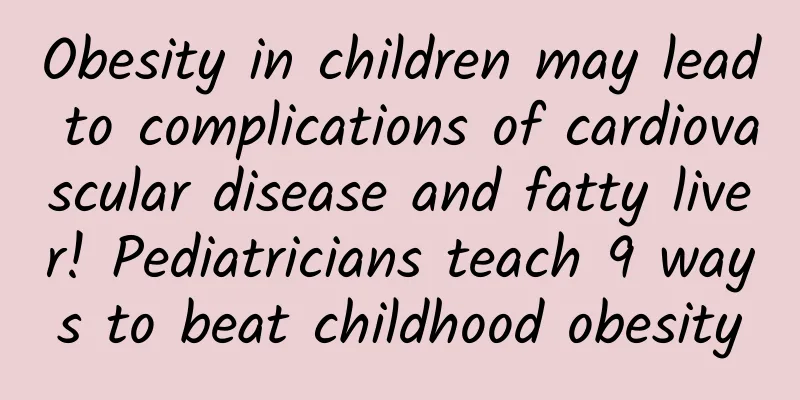Obesity in children may lead to complications of cardiovascular disease and fatty liver! Pediatricians teach 9 ways to beat childhood obesity

|
According to a survey by the Ministry of Education, the obesity rate among elementary school students in the 2017 school year was 27.6% (31.3% for boys and 23.6% for girls); the obesity rate among junior high school students was 29.5% (33.2% for boys and 25.3% for girls). Although the 2013-2016 National Nutrition and Health Status Survey showed that the rising rates of overweight and obesity among children in Taiwan seem to have slowed down, our country's child obesity rate is still the highest compared to neighboring Japan, South Korea, and Singapore. Since the COVID-19 outbreak in the past two years, children's outdoor activity time has been greatly reduced, and they even have no basic school physical education time due to class suspension or online classes at home. The time spent using 3C products outside of school has also increased significantly. Many children have lost a lot of weight during this period. This trend of worsening weight loss is more serious during the epidemic, especially among preschoolers and school-age children who are more likely to be affected than adolescents. In addition, children who are already overweight or obese are more likely to be affected than their normal-weight peers. Rapid weight gain may accelerate the deterioration of obesity-related complications. Therefore, during the COVID-19 epidemic prevention period, it is a critical time for us to pay attention to promoting children's healthy posture. It is often said that being fat as a child is not fat? Medical research reports show that 60% to 70% of obese primary school students will still be obese when they grow up; as for obese middle school students, as high as 70% to 80% will still have adult obesity problems in the future. Childhood obesity increases the risk of cardiovascular disease, fatty liver, diabetes and metabolic syndrome in present and future adulthood. It also has many effects on the skeletal muscle, respiratory, endocrine system and social learning (Figure 1). It can be said to be the root cause of modern civilization diseases. Obesity prevention and control should start from childhood, and even from pregnancy and childbirth, and extend to the entire life cycle. Causes of childhood obesity and overweight Although genetic diseases or hormonal imbalances can cause obesity, the proportion is very low, and most obesity is "simple obesity." Genetic factors: such as Prader-Willi syndrome (commonly known as "Prader-Willi") Obesogenic environment Dietary content: Sugary drinks (excessive intake of calories and fat), insufficient intake of dairy products (or calcium), insufficient intake of vegetables and fruits. Eating habits: skipping breakfast, eating out (especially fast food), eating too fast, large portions, and high-calorie snacks. Static activities: for example, watching TV and playing video games. Insufficient sleep: A study of children aged 2.5 to 6 years old found that the obesity rate of those who did not get enough sleep every day was 2.9 times that of those who got enough sleep every day. Stress: pressure from the child himself, parents or family. Impact during the fetal period Mother: maternal obesity before pregnancy or excessive weight gain during pregnancy, malnutrition during pregnancy, gestational diabetes, and pregnant women are exposed to a smoking environment. Fetus: too low or too heavy birth weight. Feeding with breast milk or infant formula during infancy is also associated with obesity. Importance of maintaining a healthy posture Although complications of obesity begin to appear in childhood, they are often ignored because the symptoms are not obvious. Many parents only discover their children’s abnormal liver function, high blood pressure, or even excessive blood sugar levels after a health check at school. In fact, by this time the child’s body may have been damaged for some time. Therefore, it is the only way to prevent and treat obesity and its complications for the whole family to establish a good lifestyle as early as possible to maintain a healthy body shape. At the same time, "constantly eating snacks and drinking drinks", "constantly holding mobile phones and tablets" and "difficulty in developing exercise habits" are reflections of modern children's lives and are also the fundamental environmental factors that cause childhood obesity. Therefore, parents should set an example to establish healthy eating and exercise habits for the whole family and persevere in order to avoid the health hazards of childhood obesity. 【9 Tips to Beat Childhood Obesity】 1. Eat five servings of vegetables and fruits every day 2. Avoid sugary drinks 3. Reduce high-calorie diet, such as saturated fat foods, potato chips, candies, etc. 4. Reduce eating out 5. Eat breakfast 6. Reduce sedentary activities, and watch TV, surf the Internet and play video games for no more than 2 hours a day 7. Arrange appropriate physical activities and exercises according to the child’s age and preferences 8. Daily physical activity time exceeds 1 hour 9. Get 9 hours of sleep Yadong Children and Adolescents Healthy Posture Promotion Clinic The "Children and Adolescents Healthy Posture Promotion Clinic" jointly established by Dr. Lin Yucheng of the Pediatric Gastroenterology Department, Dr. Li Ruhao of the Genetic Endocrinology Department and a team of nutritionists is an innovative integrated clinic. There is no need to see different departments or visit the doctor multiple times for different test items. All test data can be summarized by a dedicated personal specialist nurse for case management. The treatment course can be adjusted at any time according to the individual needs of the child, and it serves as a bridge for two-way communication with the medical team. Case Study Sharing In this integrated clinic, those who reduced their calorie intake by at least 200 calories after dietary education intervention accounted for about 54.1% of the total number of people. Since dietary habits fluctuate greatly during the change process, it takes a continuous reduction of 500 calories per day to reduce about 0.5kg in a week. Case 1: A high school boy reduced his daily calorie intake from 4,220 to 2,355 in 3 months, and maintained it in the range of 2,300-2,600 calories for 4 consecutive months. Within 5 months after starting the control, she had lost 13kg from 165kg and her BMI dropped by 4. Among the abnormal biochemical values, uric acid dropped from 9.1 mg/dL to 7.4 mg/dL over a period of 4 months, and low-density lipoprotein cholesterol dropped from 150 mg/dL to 105 mg/dL. Case 2: A high school boy who attends night school usually eats two bento boxes for one meal and has the habit of having a midnight snack after class every day. In one month, I reduced my daily calorie intake from 4,090 to 2,080 calories, and maintained it in the 2,000-2,300 calorie range for a year. Eight months after starting the control, she had lost about 10 kg from 96.5 kg, her BMI dropped by 3.7, and her waist circumference dropped by 7 cm in three months. Among the abnormal biochemical values, uric acid dropped from 9.4 mg/dL to 8.4 mg/dL over a period of 6 months, and liver index dropped to normal values. |
Recommend
High blood pressure causes dizziness and dry eyes… 3 medicinal teas to treat dizziness
Patients with hypertension are prone to symptoms ...
What should you pay attention to if you have pelvic inflammatory disease? Prevent various routes of infection
If we pay close attention, we will find that ther...
How to take care of patients with ovarian cysts?
Among gynecological diseases, ovarian cyst is one...
Is it okay to take progesterone if menstruation has not come? Go to the hospital for a check-up first
Many women experience amenorrhea due to various r...
The occurrence of female vulvar leukoplakia is caused by many factors.
Women should know about vulvar leukoplakia. After...
It is important to know the symptoms of uterine fibroids in advance
Experts unanimously remind everyone that being ab...
Can B-ultrasound detect inflammation of the uterus after miscarriage?
Can B-ultrasound detect inflammation of the uteru...
40% of office workers eat at their desks and the fishy smell makes them sick
Due to high work pressure and tight time, many of...
Can hyperprolactinemia be detected by CT scan?
There is a disease in our lives called hyperprola...
What are the typical symptoms of ectopic pregnancy
Ectopic pregnancy, also known as ectopic pregnanc...
How much does an abortion pill cost? What tests should be done before taking an abortion pill?
If the unplanned pregnancy does not exceed 49 day...
Is right ovarian rupture an ectopic pregnancy? Will there be bleeding?
Ruptured right ovarian pregnancy is a special typ...
What are the complications of ovarian cysts and how to treat them with traditional Chinese medicine
What are the complications of ovarian cysts? How ...
How to treat cervical erosion in women? These methods are the best for treating cervical erosion
In daily life, more and more women are suffering ...
Will pelvic inflammatory disease get worse during menstruation?
Will pelvic inflammatory disease get worse during...









